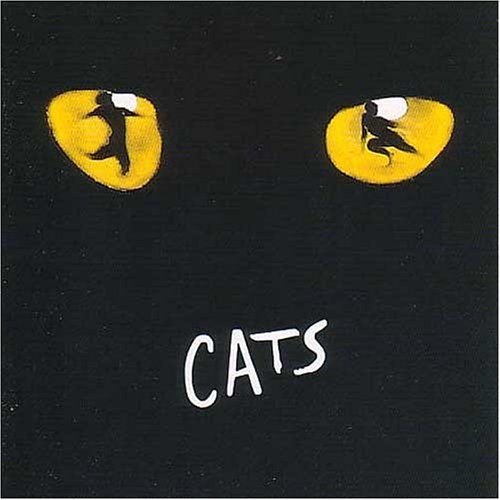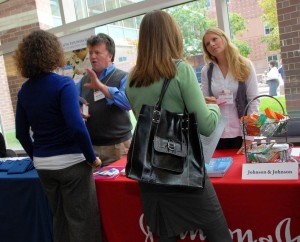Dr. Joseph Barber
1) Patience
For every 5 minutes I spend wiggling a piece of string in front of my cats to entice them to play, they only spend about 1 minute actively chasing it. They spend most of the time carefully watching it…, waiting for just the right moment to pounce on the string when it looks like they have the greatest chance of catching it unawares. This strategy seems much more successful than wildly chasing the string around and around. You could say, then, that the cats are investing a lot of time preparing for each pounce, resulting in an increased likelihood of success. Try the same thing when it comes to your cover letters and resumes, and you’ll find that you will also probably have much more success compared to sending out a large number of identical cover letters and resumes to many different employers. Tailor your application materials to each job and you’ll definitely end up with more than just a discarded old shoelace that is slightly moist with cat spit!
They spend most of the time carefully watching it…, waiting for just the right moment to pounce on the string when it looks like they have the greatest chance of catching it unawares. This strategy seems much more successful than wildly chasing the string around and around. You could say, then, that the cats are investing a lot of time preparing for each pounce, resulting in an increased likelihood of success. Try the same thing when it comes to your cover letters and resumes, and you’ll find that you will also probably have much more success compared to sending out a large number of identical cover letters and resumes to many different employers. Tailor your application materials to each job and you’ll definitely end up with more than just a discarded old shoelace that is slightly moist with cat spit!
2) Take every opportunity to walk through an open door
It doesn’t matter if I am opening a kitchen cupboard, the front door, the coat cupboard, or any type of cardboard box, there is always a cat there as soon as I do. It is as if they have never heard of the old saying about curious cats! But who knows what surprises might be on the other side of those doors, or what delicious treats could be just waiting to be found inside those boxes? By being curious and taking a bit of a risk, my cats get more information about their environment – information they can use to be even angrier at me for there not being any nice surprises or delicious treats for them! At Penn, you can also look for opportunities to find delicious treats behind different doors – if by “delicious treats” you mean the opportunity to join student groups, meet new people, learn new skills, and get involved. You’ll find that the experiences you gain from getting involved will actually help to open more doors for you later on – after all, the best resumes not only illustrate academic and research skills, but also transferable ones like leadership, management, team-work, and problem-solving.
– information they can use to be even angrier at me for there not being any nice surprises or delicious treats for them! At Penn, you can also look for opportunities to find delicious treats behind different doors – if by “delicious treats” you mean the opportunity to join student groups, meet new people, learn new skills, and get involved. You’ll find that the experiences you gain from getting involved will actually help to open more doors for you later on – after all, the best resumes not only illustrate academic and research skills, but also transferable ones like leadership, management, team-work, and problem-solving.
3) Always focus on the positive
Cats like to make a good impression. They try to impress upon people their graceful agility and poise. Every now and again, and despite all their efforts, however, they will fall. Splat! It is the cat equivalent of tripping up the stairs on the way to receive an award on stage – there is no hiding it!  But cats have an amazing ability to focus on the positive, to suggest that they actually meant to fall, because falling somehow gave them the opportunity to do something that they had wanted to do right from the start – like licking their paws, for example. Lots of things don’t quite go the way we plan. You might be doing research that isn’t leading to any useful results, through no fault of your own. When applying for jobs, you need to focus on the positive aspects of these seemingly negative experiences. You can phrase every research set back as an opportunity to try new methods or techniques, or to seek out new collaborations. Many employers value initiative and problem-solving skills, and showing that you can face adversity with an upbeat and enthusiastic attitude will be seen as a positive. What you have achieved as well as how you have been approaching challenges in your work are both important.
But cats have an amazing ability to focus on the positive, to suggest that they actually meant to fall, because falling somehow gave them the opportunity to do something that they had wanted to do right from the start – like licking their paws, for example. Lots of things don’t quite go the way we plan. You might be doing research that isn’t leading to any useful results, through no fault of your own. When applying for jobs, you need to focus on the positive aspects of these seemingly negative experiences. You can phrase every research set back as an opportunity to try new methods or techniques, or to seek out new collaborations. Many employers value initiative and problem-solving skills, and showing that you can face adversity with an upbeat and enthusiastic attitude will be seen as a positive. What you have achieved as well as how you have been approaching challenges in your work are both important.
4) Make new contacts and build on existing relationships
OK,  so this is something my cats could do better. I have three cats, and they don’t always get along. As long as they have their personal space they are good, but any peace in the house doesn’t last long. Believe me, I have tried explaining the benefits of having a good network of contacts to them – especially when I find them yowling at stranger cats through the window, but they won’t listen. Although I sometimes find them making an effort to make new professional contacts, they could certainly do more. The problem is that cats like to live in the moment. To them, time spent working on relationships for some future benefit takes away from time that could be spent in the here and now trying to gnaw through a plastic container containing muffins (no, I don’t know why they like muffins so much). What they don’t realize is that I might be more likely to share some of my muffin with them if they sat on my lap more, and at least pretended to be friendly towards me. That’s the thing about networking – you are never guaranteed that it will help you find a job, but if you treat it as an opportunity to build long-term, professional contacts and share information (i.e., give and take), you will eventually reap some benefits. Of course, it is almost certain that actively “not networking” won’t be of much help at all – unless you have really sharp claws and teeth, and really want that muffin.
so this is something my cats could do better. I have three cats, and they don’t always get along. As long as they have their personal space they are good, but any peace in the house doesn’t last long. Believe me, I have tried explaining the benefits of having a good network of contacts to them – especially when I find them yowling at stranger cats through the window, but they won’t listen. Although I sometimes find them making an effort to make new professional contacts, they could certainly do more. The problem is that cats like to live in the moment. To them, time spent working on relationships for some future benefit takes away from time that could be spent in the here and now trying to gnaw through a plastic container containing muffins (no, I don’t know why they like muffins so much). What they don’t realize is that I might be more likely to share some of my muffin with them if they sat on my lap more, and at least pretended to be friendly towards me. That’s the thing about networking – you are never guaranteed that it will help you find a job, but if you treat it as an opportunity to build long-term, professional contacts and share information (i.e., give and take), you will eventually reap some benefits. Of course, it is almost certain that actively “not networking” won’t be of much help at all – unless you have really sharp claws and teeth, and really want that muffin.
5) Make use of the resources available to you
My cats are very good at making use of the resources that are made available to them (and even those that aren’t).  Whether it is pawing at my face at 2am to be let in to the toasty bed on a cold night, or taking a sip of nicely filtered ice water that I left (for me) on my bedside table, cats are very resourceful! By hanging around the kitchen in the morning, the cats get to sit in the warm rays of the morning sun and might get the opportunity to lick the last few drops of milk from my cereal bowl once I am done (or before if I am not looking). And the cats obviously see anyone getting up from the sofa to refill their cat-licked water glass after supper as an invitation for them to sit on the just-vacated and nicely-warmed cushion. One of my cats has perfected the “you are not still using this seat, are you?” look. Are you making use of the resources available to you? Have you attended some of the workshops, discussion panels, and career fairs that Career Services organizes? Have you scheduled a one-on-one counseling sessions with an advisor? Have you explored PennLink and INet, or considered what opportunities may be open to you through On-Campus Recruiting? Do you know how to make the most of PACNet and LinkedIn? If you follow the example set by my cats, you will see that these resources are ready and available for you to exploit.
Whether it is pawing at my face at 2am to be let in to the toasty bed on a cold night, or taking a sip of nicely filtered ice water that I left (for me) on my bedside table, cats are very resourceful! By hanging around the kitchen in the morning, the cats get to sit in the warm rays of the morning sun and might get the opportunity to lick the last few drops of milk from my cereal bowl once I am done (or before if I am not looking). And the cats obviously see anyone getting up from the sofa to refill their cat-licked water glass after supper as an invitation for them to sit on the just-vacated and nicely-warmed cushion. One of my cats has perfected the “you are not still using this seat, are you?” look. Are you making use of the resources available to you? Have you attended some of the workshops, discussion panels, and career fairs that Career Services organizes? Have you scheduled a one-on-one counseling sessions with an advisor? Have you explored PennLink and INet, or considered what opportunities may be open to you through On-Campus Recruiting? Do you know how to make the most of PACNet and LinkedIn? If you follow the example set by my cats, you will see that these resources are ready and available for you to exploit.










 and the people within the network know and trust them. The best time to network from a career perspective is when you are not actively looking for a job. You have more time, and you come across as less desperate. If you work hard to help people remember you by staying in contact, then you increase the likelihood that they’ll be thinking of you when future job opportunities arise. So, take time at career fairs to share your information with people in different career fields, think of creative ways to maintain contact with them over time to establish an effective relationship, and ask the most important question of all to gain access to their network: “Do you anyone you think I should talk with to find out more information?“
and the people within the network know and trust them. The best time to network from a career perspective is when you are not actively looking for a job. You have more time, and you come across as less desperate. If you work hard to help people remember you by staying in contact, then you increase the likelihood that they’ll be thinking of you when future job opportunities arise. So, take time at career fairs to share your information with people in different career fields, think of creative ways to maintain contact with them over time to establish an effective relationship, and ask the most important question of all to gain access to their network: “Do you anyone you think I should talk with to find out more information?“